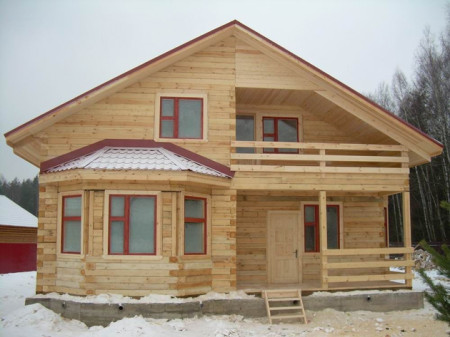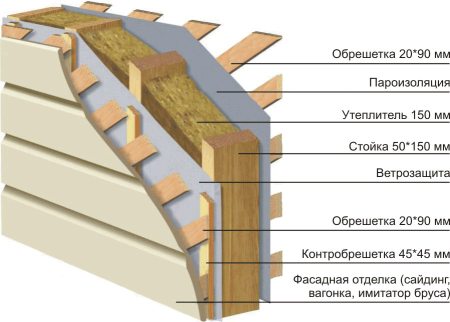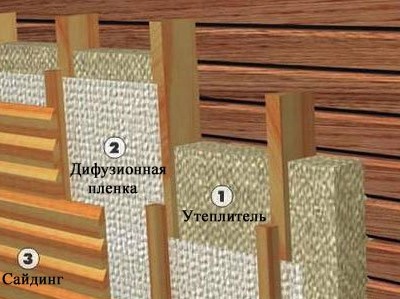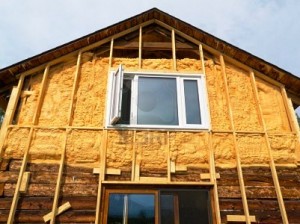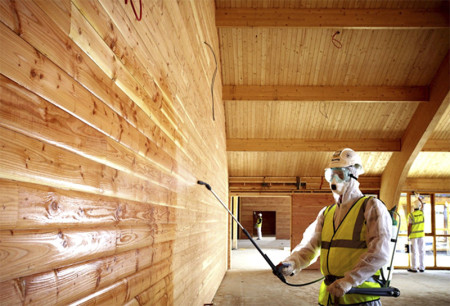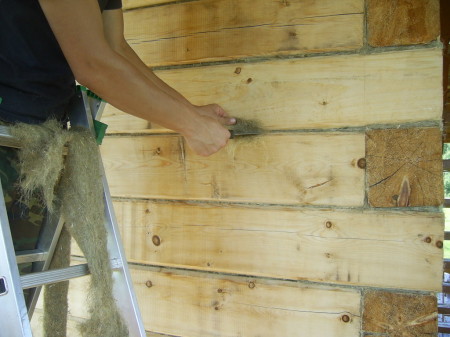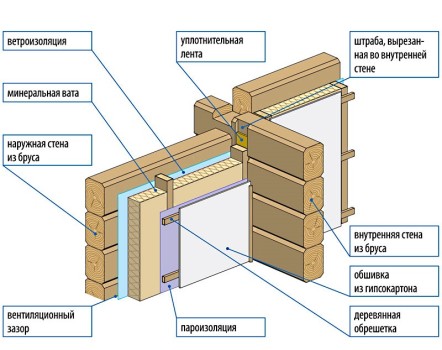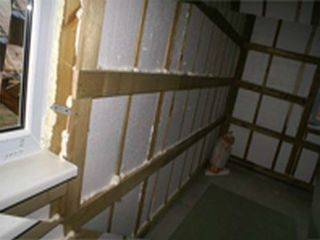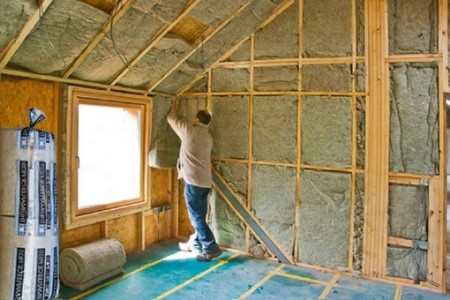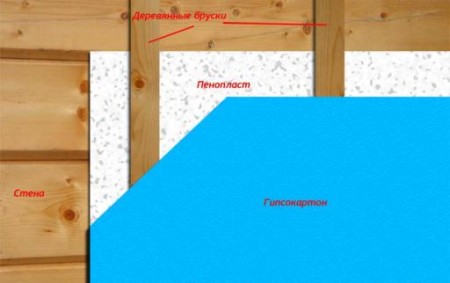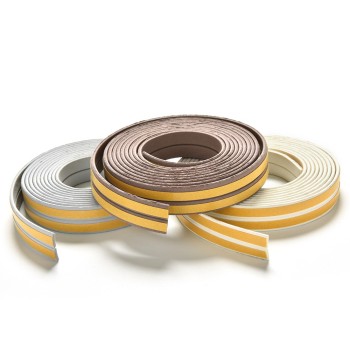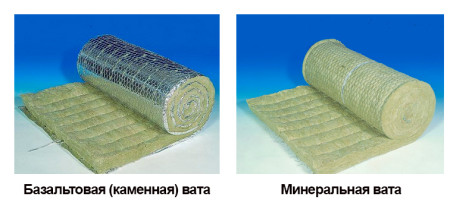A warm and cozy home is the dream of every person. Even a wooden house needs to be insulated, despite the good physical properties of the wood. Work on insulation can be carried out both inside the house and outside. About how to properly do this and choose good materials for insulation we'll talk about in this article.
Content
Warming of the house from profiled beams
Good thermal insulation is not only an indicator of high-quality construction of the house, but also a way to reduce the cost of heating and provide comfort to all residents. Therefore, the house from the profiled bar must be properly insulated. This kind of material is most suitable for the construction of private houses. First of all, it is distinguished by a good fixing density, thanks to a stud joint. But still, if the house is planned to live all year round it must be insulated. Warming must begin at the construction stage, laying at the seams tape insulation of jute or flax. It is also necessary to pay attention to the exterior finish. It protects the tree from the negative effects of atmospheric precipitation. For this you can choose siding or lining. Under them, you can lay a layer of mineral wool, which will serve as the warming of the walls. It is also necessary to take care of the internal insulation. Walls must be laid first with foil material that reflects heat inside the room. Then fix the guides on the walls and fill the distances between them with mineral wool, after which everything is sewed with gypsum board. Do not use expanded polystyrene, roofing material and similar materials. They have low hygroscopicity and can cause rotting of the tree. In addition, it is necessary to conduct insulation of the floor and ceiling. Windows and doors should not have gaps. Having completed these simple manipulations, you will get a very warm and comfortable house for a year-round living.
How to insulate a house from a bar
Any house can freeze in severe frosts. This is not insured, and a wooden house erected from a bar. That the house was always warm and the walls did not damp in the winter, the dwelling should be insulated. These works should be approached in a comprehensive manner and carry out work both outside and inside the premises.
warming the house out of the timber outside
External insulation has a number of undeniable advantages:
- a significant reduction in heat losses, as a result of the reduction in heating costs;
- additional protection from the negative impact of the environment;
- updating the appearance of the house;
- there are no losses in the footage of the premises.
It is also necessary to consider the following nuances:
- use of high-quality materials;
- compliance with the technology of laying;
- conducting waterproofing works.
There are three main types of outdoor insulation of buildings:
- hinged ventilated facade;
- installation of insulation under siding;
- spraying of polyurethane foam.
Let's consider each of the methods in more detail.
Ventilated facade allows the walls of the house to breathe. Its installation is not complicated, but it requires accuracy. First of all, the walls of the house make a vertical crate of bars, which are fixed with screws. Everything must be done exactly, for this, the crate is checked with a level. After that, the resulting crate is laid by foxes of mineral wool, and the material is attached to the walls with special dowels. To implement the ventilation of the facade, a gap of at least 5 cm is required. This can be achieved by fixing to the crate of the bars. After that, you can sew the walls with a lining or side-sawn.
Warming under siding. This insulation is carried out in the same way as the previous one. The only difference is the lack of clearance between the heater and siding. Various materials can be used for insulation:
- mineral or glass wool;
- styrofoam;
- polyurethane foam.
Spraying of polyurethane foam not so long ago appeared on the market of insulation of facades of houses. This process is quite fast and easy to perform. A great advantage is good sound insulation and non-flammability of the material. The material is environmentally friendly. Also you do not need additional fasteners. After spraying the material on the walls of the house, it can be sewed with any finishing material you like.
Having chosen one of the presented methods, you will receive a qualitative warming of your house.
warming the house from the inside
In the internal insulation of the walls need both old and newly built houses made of wood. The process of warming includes several stages:
- treatment of walls;
- erection of the crate;
- a bookmark of a heater;
- creation of ventilation;
- interior finishing.
The walls of the house must necessarily be treated with antiseptics. This will help prevent the development of fungus and rot in the wood, as well as prevent damage to it by various insects. Even the smallest slits are treated.
After the surface dries, it is necessary to seal the cracks. To do this, you need to use jute or linen fiber and a chisel.
After all the slots are filled, it is necessary to provide a vapor barrier. This will allow the tree not to absorb excess moisture. For this, a special film must be laid on the walls, ceiling and floor. After this, they proceed to the installation of the crate. To the wall fix beams section 5 * 10 cm with self-tapping screws. After that we lay the insulation material. Its size should exceed by 1 - 2 cm the distance between the beams of the crate. For reliability, heat insulation sheets are fixed to the wall with special anchors with a large bonnet. After all is filled with the material over the layer of film can be laid. After this, you can proceed to finish the room. Planking on the floor board or any other material you choose. Walls and ceiling can be sewed with lining or plasterboard. Internal insulation is a fairly simple process. The main thing is to follow clearly all the stages of the work.
Material of house warming
To date, the market for building materials is a large selection of insulation. They have different composition and physical properties. Some materials are best suited for outdoor insulation, others are more recommended for interior work. So outside the house from a bar can be warmed:
Styrofoam. This is a fairly popular material for thermal insulation works. It is fixed to the walls of the house with a special glue. In addition, you can fix the material with special bolts. This material has both positive and negative qualities. The pluses are:
- not prone to fungi and mold;
- does not absorb moisture;
- the material is easy;
- an affordable price (on average, cubic meter of material costs 1,600 rubles).
The minuses include:
- is subject to mechanical failure and needs additional protection;
- airtight;
- must be protected from paintwork materials that can destroy the foam.
Mineral wool - a great material for warming the house. It has excellent physical properties, it perfectly passes air, and removes excess moisture. With such a heater, the walls of the house will breathe. Easy to use, easy and quick to assemble. The cost of packing the material ranges from 400 to 740 rubles. It all depends on the material class.
Styrofoam environmentally friendly material, to that it is not subject to burning. With proper installation, the insulation of this material will last up to 30 years. On average, the cost of this material is 1,300 rubles per package. The number of plates in the package can vary from 5 to 20 pieces.
The choice of material is a private matter for everyone. Be guided by financial opportunities and personal preferences. Still need to take into account the convenience and speed of stacking the material.
Proper insulation of the house from the timber
In the insulation of the home, there are also a number of nuances. To such works it is best to proceed 1 to 2 years from the construction of the house. Cant, like all other materials since time shrinks. First, it is necessary to plow all available slots with the help of special materials (jute or linen fiber). Both materials are made from natural raw materials and will serve as an excellent insulation. It is desirable to insulate the house from the outside and from the inside. Also do not forget about the floor, ceiling and attic space. After a lot of heat can escape through the insulated roof. For the insulation of walls and floors, you can use various materials that have already been mentioned in the article. The ceiling from the attic side can be covered with expanded clay or sawdust, this is a fairly simple and affordable way of warming, which has been used for a long time. After the main work is finished, pay attention to the windows and the entrance door, they also need to be insulated. Warming of the door can be reduced to two stages:
- insulation of the box;
- insulation of the door itself.
With the insulation of the door frame, everything is quite simple now, various seals are on the market. They are made of foam rubber and rubber. Most often they have a self-adhesive basis. The models from rubber proved to be the best ones. They are enough to glue to the box from the sides and above, this will give a tight fit of the door and, accordingly, eliminate the loss of heat.
If the entrance door is thin, then in winter it will freeze. It is quite easy to heat it:
- foam rubber;
- dermantin;
- decorative carnations.
The door must be removed from the hinges and unscrewed by the metal elements. It is necessary to put it to work comfortably. Evenly distribute the foam on the surface, flush with the door. After that we measure the piece of dermantine by several centimeters wider than the door, this is the allowances. We begin to nail the material from the sides of the door, for this you can use a construction stapler, then attach the bottom. And in the last turn, so that the canvas is laid evenly on the top. After that, the surface of the door is covered with decorative carnations. With their help, you can not only decorate the door with an interesting ornament, but also additionally fix the upholstery. Everything is much easier with windows. Most manufacturers produce sealed and insulated products designed for Russian climatic conditions. It is not difficult to properly insulate a house. We must do everything on conscience and not forget about the little things.
Than to insulate walls from within
Before insulating the walls inside the dwelling, it is necessary to note all the advantages and disadvantages of this method. The pluses are:
- carrying out works at any time of the year;
- no scaffold required.
The minuses include:
- reduction of the area of premises;
- violation of air exchange, as a result of which fungus and mold may appear.
Therefore, the insulation must be selected carefully and it is better to seek advice from a specialist. The following factors should be taken into account when choosing a material:
- durability;
- safety for human health;
- protection from burning;
- good thermal insulation properties;
- resistance to aging and preservation of form.
To insulate the house from the timber, it is best to give preference to mineral or basalt cotton wool. This material has a low fire hazard. The service life is from 15 years and more. Also, this material has good thermal conductivity and is able to remove excess moisture that protects the tree from spoilage. The main and indisputable advantage is the ease of installation. Warm up the room with this material, you can not resort to anyone's help.
This article describes how to insulate a house from a bar. Attention is paid to both external and internal insulation. It also tells how to avoid heat loss by warming the doors. Using the advice of the article, you can quickly and effectively warm your home. Successful warmth.



